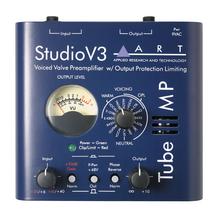ART V3 Studio Preamp
![]()
![]()
![]()
![]()
![]()
![]()
![]()
![]()

A very long time ago, before there were megapixels, WiFi, microprocessors or white LEDs, electronic stuff ran on vacuum tubes. An iPod built around vacuum tube technology would occupy an area roughly the size of Nebraska and require a dedicated nuclear power plant to light it up, so the disappearance of these quaint articles of pre-history isn’t a bad thing, for the most part.
At least, it isn’t a bad thing unless you play guitar.
Electric guitars and vacuum tube amplifiers go together like liberal politicians and mendacity, save that electric guitars are more fun. Solid state amplifiers, while a lot less likely to glow bright blue during power chords or explode unexpectedly part way through a gig, lack the tonal warmth of their distant and more treacherous ancestors. Vacuum tubes, being largely mechanical devices, imposed a measurable level of distortion upon whatever they amplified. While this resulted in really disturbing specifications for the audio equipment that used this technology back in the day, vacuum tube distortion actually sounds really sweet.
For decades after the twilight of the vacuum tube gods, amplifier designers tried to devise solid-state vacuum tube simulators… largely unsuccessfully. Tubes are inherently funky, and funkiness just isn’t something that can be programmed.
The Applied Research and Technology V3 Studio Preamp offers real tube sound for the first time in about a quarter of a century by virtue of there being a real tube inside it. While of modern manufacture, the traditional 12AX7A dual triode that drives this device is as warm and fidelity-challenged as its pre-solid state ancestors. Plug in a guitar, close your eyes and you’ll swear you were playing through a beat up circa-1965 Marshall head that’s held together with enough duct tape to envelop a rhinoceros.
While the ART V3 preamp captures the warmth and expression of a classic tube amplifier, it doesn’t include anything like the noise and hum of those vanished epochs. It’s probably a grand irony of history that long after they were state of the art, vacuum tubes manufactured in the new millennium are way better than the tubes that came before them. The one in the ART V3 preamp has been “hand selected,” according to the device’s manufacturer, and is remarkably quiet.
While there’s unquestionably a tube in the V3 preamp, most of its circuitry is solid state and elegantly sophisticated, heralding impressive specifications. It offers quarter-inch and XLR inputs and outputs, with 48-volt phantom power, should you want to use it to drive a microphone. You can select varying degrees of tube warmth, and it has an internal limiter to keep it from detonating your speakers unexpectedly. It has a phase reversal switch to minimize pickup hum – a useful option if you like vintage electric guitars.
The front of the preamp’s case features slots to let you peek at the tube, should you be feeling nostalgic. There’s also a genuine analog VU meter to look at, just like at the dawn of time.
In use, the ART V3 preamp is effortless to set up, and pretty much infallible. Everything it does sounds good, and getting a feel for its tone selection dial will only entail your deciding which of its subtle voices best suits your playing.
While the ART preamp is ideally suited to an electric guitar, it’s equally amenable to suffusing its warmth upon electric keyboards and acoustic instruments played through a microphone. It adds a remarkable dimension to vocals. It transformed m’lady’s electric cello into something truly dark and sinister, and neither she nor the preamp were to be seen for several days after she discovered it.
Aside from being sonically impressive, the ART V3 preamp is really nicely made, with a robust steel case, comfortable controls and intuitive, easily located connectors. With a street price of about seventy dollars, it would be a crime against history not to own one.
Our V3 preamp came from Musician’s Friend, who price-matched it from a slightly cheaper supplier and shipped it very nearly instantaneously.